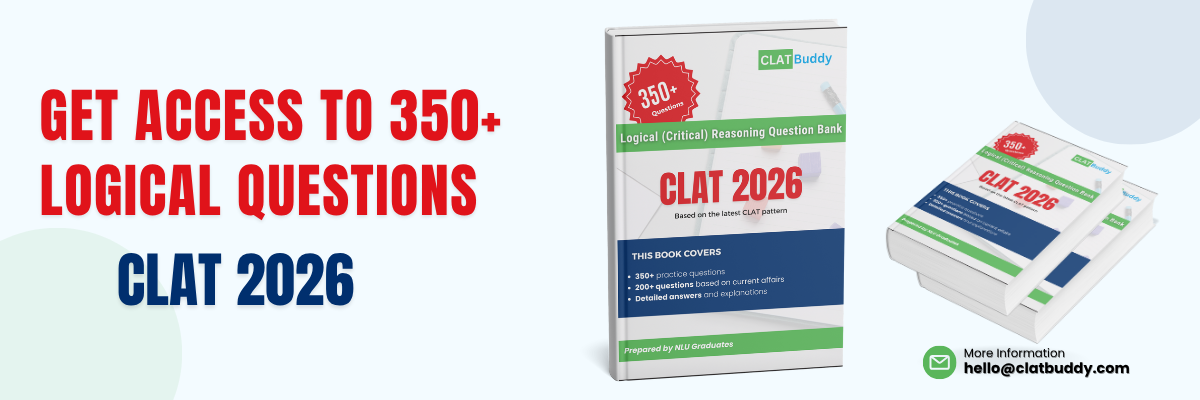Logical (Critical) Reasoning Questions for CLAT | QB Set 68

On October 3, the Supreme Court of India declared that the caste-based division of labour in prisons is unconstitutional, marking a significant step toward addressing systemic discrimination within the country’s correctional facilities. The ruling was delivered by a three-judge Bench, led by Chief Justice D.Y. Chandrachud, which struck down several provisions in state prison manuals that upheld such practices, stating that these violated the fundamental rights of prisoners.
The court was responding to a Public Interest Litigation (PIL) filed by journalist Sukanya Shantha, which highlighted discriminatory provisions in the prison manuals of states like Tamil Nadu, Uttar Pradesh, West Bengal, Odisha, Maharashtra, and Kerala. One prominent example was the segregation of Thevars, Nadars, and Pallars in different sections of Tamil Nadu’s Palayamkottai Central Jail, an explicit instance of caste-based segregation. In Rajasthan, the 1951 Prison Rules allocated latrine duties to the “Mehtar” caste, a Scheduled Caste community, while Brahmins or “high caste” prisoners were assigned to kitchen duties, further entrenching caste divisions.
The Supreme Court also addressed how prison manuals perpetuate colonial stereotypes. Despite the repeal of the Criminal Tribes Act of 1871, which labelled certain communities as “born criminals,” some prison manuals continued to categorise these groups as “habitual offenders.” Such labels, without any conviction, were found to reinforce colonial-era prejudices and exacerbate the marginalisation of these communities.
The Bench ruled that caste as a classification criterion can only be justified if it aims to uplift victims of caste discrimination. The current provisions failed in this regard, contravening Article 14 of the Constitution, which guarantees equality. The court pointed out that segregating prisoners based on caste perpetuates animosity and caste differences, further offending principles of equality.
Additionally, the court identified both direct and indirect discrimination, as marginalised communities were often assigned menial tasks like cleaning, while prisoners from higher castes were given cooking duties. This practice was flagged as a violation of Article 15(1) of the Constitution. The court also noted that such discriminatory practices amounted to untouchability, which is prohibited under Article 17 of the Constitution. The ruling reaffirms the fundamental rights of all prisoners to be treated with dignity and equality, regardless of their caste.
1. What is the central issue addressed by the Supreme Court of India in its ruling on caste-based labour division in prisons?
A) The legality of caste-based reservations in educational institutions
B) The unconstitutionality of caste-based segregation of prisoners
C) The economic benefits of caste-based labour divisions in prisons
D) The efficiency of manual labour assignments in prison systems
2. Which constitutional article does the Supreme Court ruling primarily invoke when declaring the caste-based division of labour in prisons as unconstitutional?
A) Article 21, the right to life and personal liberty
B) Article 19, the right to freedom of speech and expression
C) Article 14, the right to equality
D) Article 356, emergency provisions
3. Which of the following best reflects the reasoning behind the Supreme Court’s decision to strike down provisions that perpetuate caste-based labour divisions in prisons?
A) Caste-based divisions in prisons maintain social order and discipline
B) Assigning labour based on caste is an outdated practice that reinforces colonial-era stereotypes
C) The prison labour system is a matter of state policy, not constitutional rights
D) Caste-based labour assignments ensure better management of prison resources
4. Which provision of the Constitution was violated by the segregation of prisoners from marginalised communities and assigning them menial tasks?
A) Article 23, prohibition of traffic in human beings and forced labour
B) Article 19, freedom of movement
C) Article 15(1), prohibition of discrimination on the grounds of religion, race, caste, sex, or place of birth
D) Article 51, promotion of international peace and security
5. The court’s judgment reflects the idea that treating prisoners differently based on caste amounts to:
A) A form of social reform for marginalised prisoners
B) The continuation of historical caste prejudices and discrimination
C) An appropriate use of prison labour to rehabilitate prisoners
D) A necessary practice to maintain prison hierarchies
Answers and Explanations:
- Answer: B) The Supreme Court ruling addressed the unconstitutionality of caste-based segregation and labour divisions in prisons, focusing on discrimination within correctional facilities.
- Answer: C) Article 14, which guarantees equality before the law, was the primary constitutional basis for the ruling, emphasising that caste-based segregation violates the right to equality.
- Answer: B) The court highlighted that assigning labour based on caste reinforces colonial-era stereotypes and discrimination, which contradicts the principles of equality in a modern constitutional democracy.
- Answer: C) The judgment identified a violation of Article 15(1), which prohibits discrimination on various grounds, including caste, thereby outlawing such practices in prisons.
- Answer: B) The court found that caste-based labour assignments perpetuate historical prejudices and further marginalise already disadvantaged communities, contrary to the constitutional mandate for equality and dignity.
Calling all law aspirants!
Are you exhausted from constantly searching for study materials and question banks? Worry not!
With over 15,000 students already engaged, you definitely don't want to be left out.
Become a member of the most vibrant law aspirants community out there!
It’s FREE! Hurry!
Join our WhatsApp Groups (Click Here) and Telegram Channel (Click Here) today, and receive instant notifications.








